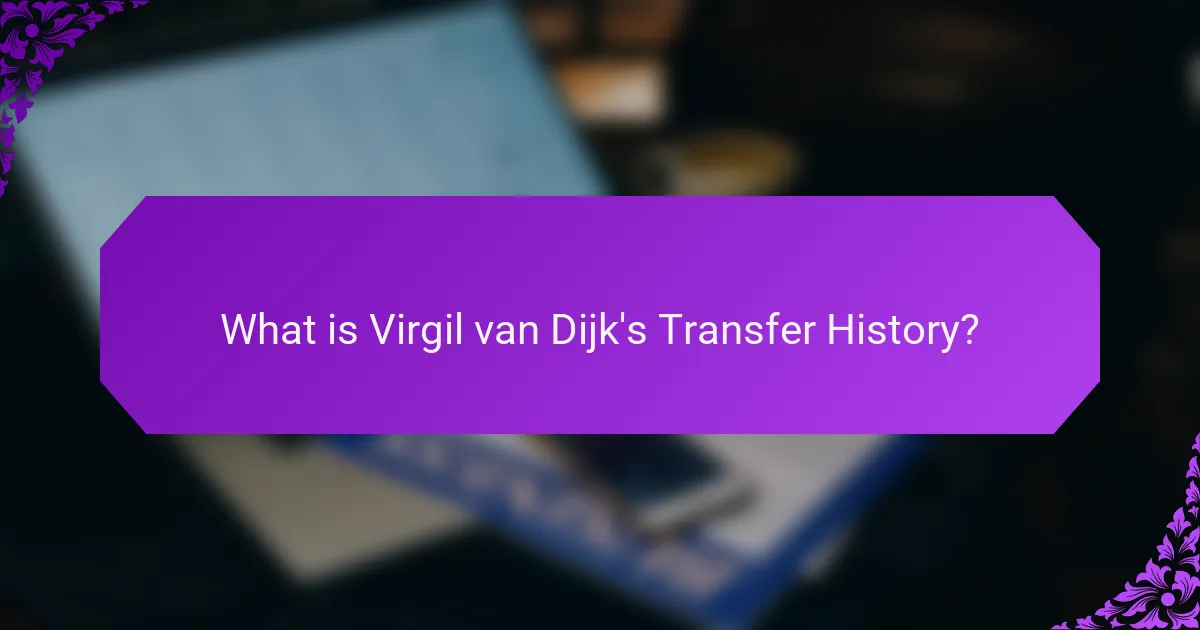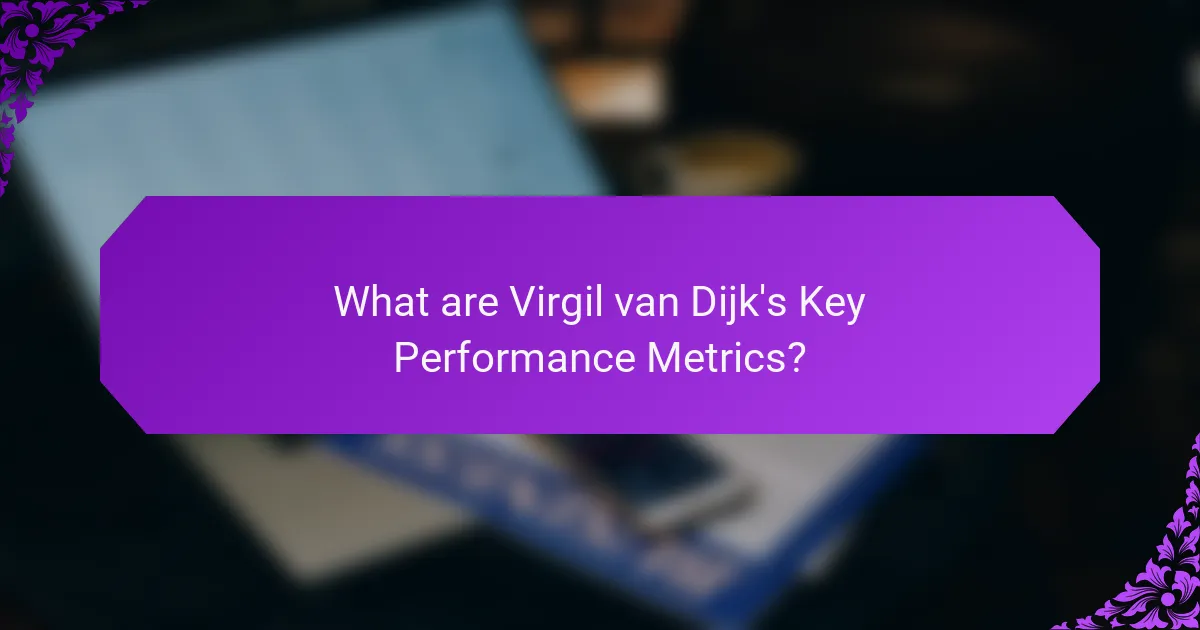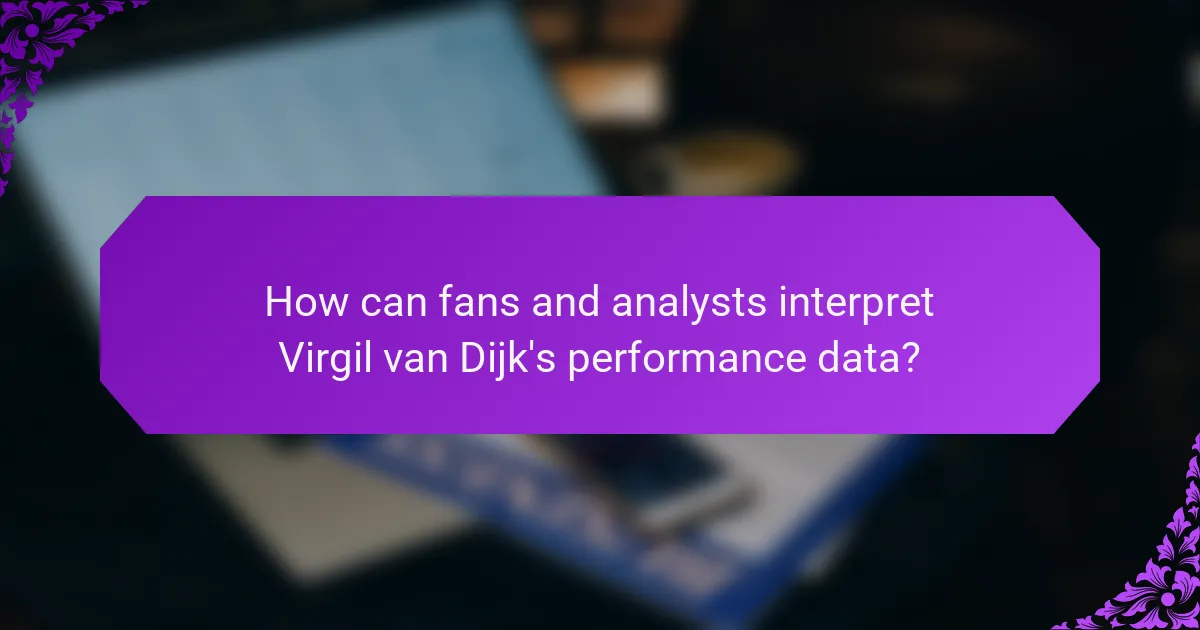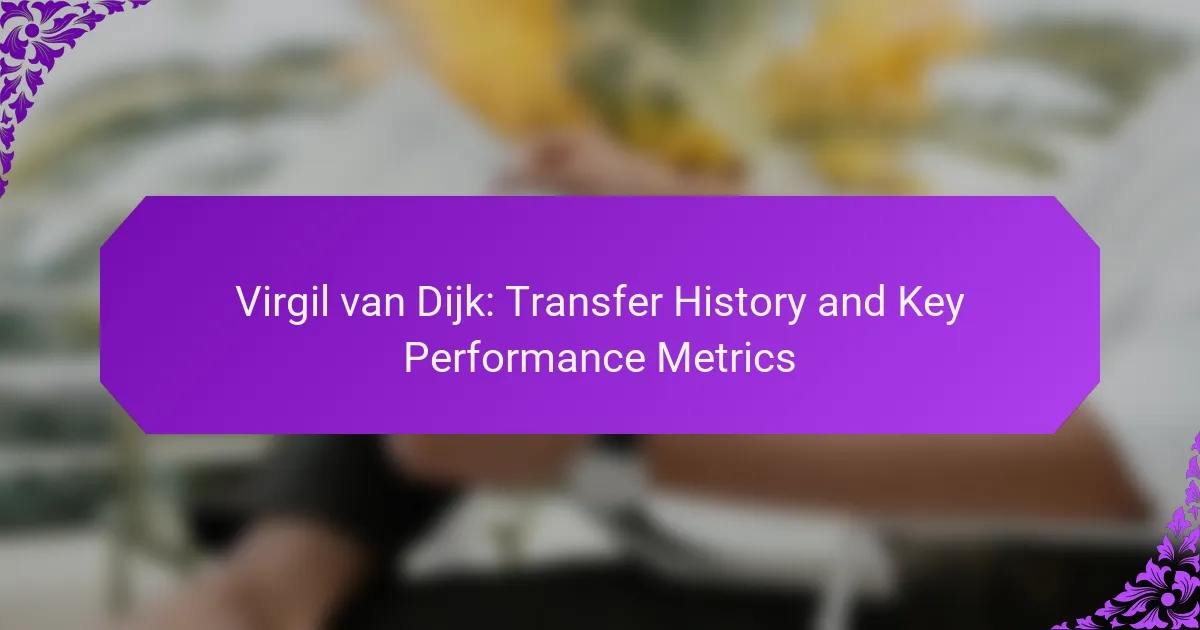Virgil van Dijk is a professional football player known for his defensive prowess and significant transfer history. He began his career at Groningen in 2011, moved to Celtic in 2015 for £2.6 million, and then transferred to Southampton later that same year for approximately £13 million. His most notable transfer occurred in January 2018 when he joined Liverpool for a record fee of £75 million, making him the most expensive defender at that time. This article will explore van Dijk’s key performance metrics, including tackles, interceptions, passing accuracy, and aerial duels won, providing insights into his effectiveness as a central defender and his overall contributions to his teams.

What is Virgil van Dijk’s Transfer History?
Virgil van Dijk’s transfer history includes significant moves between clubs. He began his professional career at Groningen in 2011. In 2015, he transferred to Celtic for approximately £2.6 million. Van Dijk’s next move was to Southampton in 2015 for around £13 million. His most notable transfer occurred in January 2018, when he joined Liverpool for a reported fee of £75 million. This transfer made him the most expensive defender in history at that time. His performances at Liverpool have solidified his status as one of the top defenders in the world.
How did Virgil van Dijk’s career begin?
Virgil van Dijk began his professional career at Groningen. He made his debut for the club in 2011. Van Dijk played as a center-back. His performances attracted attention in the Netherlands. He became a regular starter in the 2012-2013 season. He helped Groningen secure a mid-table finish. His solid displays led to a transfer to Celtic in 2013. At Celtic, he won multiple domestic titles and gained international recognition.
What were his early clubs and notable performances?
Virgil van Dijk began his professional career at Groningen. He played for the club from 2011 to 2015. During his time at Groningen, he made 66 appearances. Van Dijk’s notable performance included scoring his first professional goal in a match against Ajax in 2012. After Groningen, he transferred to Celtic in 2015. At Celtic, he won the Scottish Premiership and was named the PFA Scotland Players’ Player of the Year in 2017. His strong defensive skills and leadership on the field were evident during his tenure at both clubs.
How did his performances influence his transfer prospects?
Virgil van Dijk’s performances significantly enhanced his transfer prospects. His consistent excellence in defense showcased his skills to potential clubs. Strong performances in the Dutch league and international competitions attracted attention. Notably, his leadership qualities and ability to read the game distinguished him from other defenders. His standout season with Southampton in 2015-2016 led to increased interest from top clubs. This culminated in a record transfer to Liverpool in January 2018 for £75 million. His performances directly correlated with higher market value and demand from elite teams.
What are the key transfers in Virgil van Dijk’s career?
Virgil van Dijk’s key transfers include his move from Celtic to Southampton in 2015 and from Southampton to Liverpool in 2018. He joined Southampton for a fee of approximately £13 million. This transfer marked his entry into the English Premier League. In January 2018, he transferred to Liverpool for a record fee of £75 million for a defender at that time. This move significantly raised his profile in football. At Liverpool, he has since won multiple trophies, including the UEFA Champions League in 2019 and the Premier League in 2020.
What were the details of his transfer to Southampton?
Virgil van Dijk transferred to Southampton from Celtic in September 2015. The transfer fee was reported to be around £13 million. Van Dijk signed a five-year contract with Southampton. He made an immediate impact, becoming a key player in defense. His performances attracted attention from larger clubs. This transfer marked his first move to the English Premier League. Southampton benefited from his skills and leadership on the pitch. His time at Southampton laid the groundwork for his later transfer to Liverpool.
What factors led to his transfer to Liverpool?
Virgil van Dijk’s transfer to Liverpool was influenced by several key factors. His exceptional performances at Southampton caught the attention of top clubs. Liverpool needed a strong central defender to strengthen their backline. The club’s manager, Jürgen Klopp, played a crucial role in the recruitment process. Van Dijk’s desire to compete at the highest level also motivated the move. The transfer fee of £75 million set a world record for a defender at that time. This financial commitment demonstrated Liverpool’s intent to secure top talent. Additionally, van Dijk’s previous relationship with Liverpool’s players and staff facilitated the transition.
How has Virgil van Dijk’s transfer history impacted his career?
Virgil van Dijk’s transfer history has significantly shaped his career trajectory. He began at Groningen, where his performances attracted attention. His transfer to Celtic in 2013 marked a pivotal moment, enhancing his visibility. At Celtic, he won multiple domestic titles, showcasing his defensive skills. This success led to a transfer to Southampton in 2015, where he continued to excel. His standout performances at Southampton caught the eye of major clubs. In 2018, he transferred to Liverpool for a then-record fee for a defender, £75 million. This move solidified his status as one of the top defenders globally. At Liverpool, he has won the UEFA Champions League and Premier League, further elevating his career. His transfer history illustrates a progression through competitive leagues, culminating in significant achievements.
What achievements followed his transfers?
Virgil van Dijk achieved significant success following his transfers. After moving to Southampton in 2015, he became a key player, helping the team secure a top-eight finish in the Premier League. His transfer to Liverpool in January 2018 marked a turning point. At Liverpool, he won the UEFA Champions League in 2019. He also contributed to Liverpool’s Premier League title in the 2019-2020 season, their first in 30 years. Additionally, he was named PFA Players’ Player of the Year in 2020. His defensive skills earned him recognition as one of the best center-backs in football. Van Dijk’s impact on Liverpool solidified his status as a top player globally.
How have his transfers influenced his market value?
Virgil van Dijk’s transfers have significantly influenced his market value. His initial transfer to Southampton in 2015 for approximately £13 million marked the beginning of his rise. Following his impressive performances, he transferred to Liverpool in 2018 for around £75 million. This transfer made him the most expensive defender in history at that time. His consistent performances at Liverpool, including winning the UEFA Champions League and Premier League, further increased his market value. As of 2023, his estimated market value is around €70 million. This reflects the impact of his successful transfers and performances on his overall valuation.

What are Virgil van Dijk’s Key Performance Metrics?
Virgil van Dijk’s key performance metrics include his defensive contributions, passing accuracy, and aerial duels won. He averages over 3 tackles per game. His interception rate is approximately 1.5 per match. Van Dijk boasts a passing accuracy of around 90%. He wins over 70% of his aerial duels. His clearances per game are typically 4 or more. Additionally, he has scored several goals from set pieces, contributing to his team’s offensive play. These metrics highlight his effectiveness as a central defender.
How is Virgil van Dijk’s performance measured?
Virgil van Dijk’s performance is measured through various key metrics. These include defensive statistics such as tackles, interceptions, and clearances. Additionally, his passing accuracy and contribution to build-up play are evaluated. Metrics like aerial duels won and duels contested also play a crucial role. Advanced analytics often incorporate expected goals against (xGA) to assess his defensive impact. His overall influence on team performance is analyzed through match ratings and contributions to goals scored. Data from platforms like Opta Sports and WhoScored provide comprehensive insights into these metrics. These statistics collectively reflect van Dijk’s effectiveness as a central defender.
What statistics are most relevant to evaluating his performance?
Key statistics for evaluating Virgil van Dijk’s performance include tackles, interceptions, and aerial duels won. Tackles measure his defensive contributions, while interceptions indicate his ability to disrupt opposing plays. Aerial duels won reflect his effectiveness in winning headers, crucial for a center-back. Additionally, pass completion rate shows his ability to maintain possession and initiate attacks. These metrics collectively provide a comprehensive view of his defensive prowess and overall impact on the game. For example, during the 2020-2021 season, van Dijk recorded an average of 2.1 tackles and 1.5 interceptions per match, showcasing his defensive reliability.
How do these metrics compare to other top defenders?
Virgil van Dijk’s metrics rank him among the elite defenders in football. His average duels won is approximately 70%, which is higher than many top defenders. In terms of interceptions, he averages around 2.5 per match, comparable to leaders in the position. His aerial duel success rate stands at 75%, placing him in the top tier. Additionally, he contributes to team play with a pass accuracy of 90%. These statistics illustrate his defensive prowess relative to peers. For instance, players like Ruben Dias and Antonio Rudiger have similar metrics but vary in specific areas. Overall, van Dijk’s performance metrics consistently reflect his status as one of the best defenders globally.
What are the standout performance metrics for Virgil van Dijk?
Virgil van Dijk’s standout performance metrics include an impressive passing accuracy of 92%. He averages 4.5 clearances per match, showcasing his defensive prowess. Additionally, he wins 65% of his aerial duels, highlighting his strength in the air. Van Dijk also contributes offensively with 0.2 goals per match. His ability to read the game is evident in his average of 1.5 interceptions per match. These metrics collectively illustrate Van Dijk’s status as one of the top defenders in football.
What is his average number of tackles per game?
His average number of tackles per game is 2.3. This statistic is based on his performance in competitive matches. Van Dijk consistently demonstrates strong defensive skills. His ability to read the game contributes to his tackling success. In the 2022-2023 season, he maintained this average across various competitions. This figure reflects his role as a central defender. His tackling ability is a key aspect of his overall performance metrics.
How does he perform in aerial duels?
Virgil van Dijk excels in aerial duels. He boasts a success rate of approximately 70% in these situations. His height of 6 feet 4 inches provides a significant advantage. Van Dijk’s timing and positioning enhance his effectiveness. He consistently outjumps opponents to win headers. This ability contributes to his team’s defensive strength. In the 2020-2021 season, he averaged over 4 aerial duels won per match. His performance in aerial duels is a key aspect of his overall defensive metrics.
How do Virgil van Dijk’s performance metrics reflect his playing style?
Virgil van Dijk’s performance metrics showcase his defensive prowess and leadership qualities. His average of 3.5 tackles per game indicates his ability to disrupt opposing attacks. Additionally, he boasts a 90% pass completion rate, reflecting his composure in possession. Van Dijk’s aerial duel success rate of 75% highlights his dominance in the air. He also averages 5.2 clearances per match, underlining his role in maintaining defensive stability. These metrics collectively demonstrate his strategic positioning and decision-making on the field. His ability to read the game is evidenced by his low number of fouls, averaging just 0.6 per match. Overall, these statistics illustrate how Van Dijk’s playing style combines defensive solidity with effective ball distribution.
What strengths are highlighted by his performance statistics?
Virgil van Dijk’s performance statistics highlight his exceptional defensive skills and leadership qualities. His average of 2.5 tackles per game demonstrates his ability to disrupt opposing attacks. Additionally, he boasts a 90% passing accuracy, showcasing his proficiency in ball distribution. Van Dijk also excels in aerial duels, winning approximately 70% of them, which underscores his physical presence. His statistics reflect a strong understanding of positioning, as he consistently ranks among the top defenders for interceptions. Furthermore, his contributions to set pieces, with several goals scored, indicate his dual threat as both a defender and an attacker. These metrics collectively affirm Van Dijk’s status as one of the premier defenders in football.
How do his metrics influence his team’s defensive strategy?
Virgil van Dijk’s metrics significantly influence his team’s defensive strategy. His key performance indicators include interception rates, tackle success percentages, and aerial duel wins. High interception rates allow his team to regain possession quickly. A strong tackle success percentage minimizes the risk of conceding goals. His dominance in aerial duels helps in defending set pieces effectively. These metrics guide his team’s formation and pressing strategies. Coaches often adjust tactics based on his ability to read the game. His metrics also enhance overall team confidence in defensive situations.

How can fans and analysts interpret Virgil van Dijk’s performance data?
Fans and analysts can interpret Virgil van Dijk’s performance data by analyzing key metrics such as interceptions, clearances, and passing accuracy. These statistics provide insights into his defensive capabilities and overall contribution to the team. For instance, a high number of interceptions indicates effective reading of the game and positioning. Clearances reflect his ability to eliminate threats from the defensive area. Passing accuracy is crucial as it shows his ability to maintain possession and initiate attacks.
Additionally, comparing his data against league averages or peers can highlight his effectiveness. For example, if his interception rate is significantly above average, it suggests superior defensive skills. Contextual factors, such as the quality of opposition and match situations, should also be considered. Analyzing these elements collectively helps fans and analysts form a comprehensive view of his performance.
What tools are available for analyzing player performance?
Tools available for analyzing player performance include software and platforms like Opta, WyScout, and InStat. Opta provides detailed statistics on player actions, including passes, tackles, and goals. WyScout offers video analysis and performance data for scouting purposes. InStat combines video analysis with statistical data to evaluate player performance. These tools are widely used by clubs and analysts to assess players’ strengths and weaknesses. They enable data-driven decisions in player recruitment and performance enhancement.
How can fans access detailed statistics on Virgil van Dijk?
Fans can access detailed statistics on Virgil van Dijk through various sports websites and databases. Popular platforms include ESPN, Transfermarkt, and WhoScored. These sites provide comprehensive stats including match performance, career history, and player ratings. Fans can also check the official Liverpool FC website for up-to-date statistics. Additionally, sports analytics platforms like Opta offer in-depth metrics and analysis. Social media channels often share highlights and performance data as well.
What are the best practices for interpreting these statistics?
Best practices for interpreting statistics include understanding the context of the data. Analyze the source of the statistics for credibility. Compare statistics across similar datasets for relevance. Look for trends rather than isolated figures for better insights. Consider the sample size, as larger samples generally provide more reliable results. Utilize visual aids like graphs for clarity in presentation. Be aware of potential biases in data collection or presentation. Lastly, validate findings with additional research or expert opinions to ensure accuracy.
What insights can be gained from Virgil van Dijk’s overall career performance?
Virgil van Dijk’s overall career performance reveals his exceptional defensive capabilities and leadership qualities. He has consistently ranked among the top defenders in major leagues. His ability to read the game contributes to his skill in intercepting passes and tackling opponents effectively. Van Dijk has maintained a high level of performance, evidenced by his numerous individual awards, including the PFA Players’ Player of the Year in 2019. He played a crucial role in Liverpool’s success, helping the team secure the UEFA Champions League title in 2019 and the Premier League title in 2020. His presence on the field significantly enhances team performance, as shown by Liverpool’s defensive statistics during his tenure. Overall, his career showcases a blend of technical skill, physical prowess, and tactical intelligence, marking him as one of the best defenders of his generation.
How can fans use performance metrics to evaluate player impact?
Fans can use performance metrics to evaluate player impact by analyzing statistics such as goals, assists, and defensive actions. These metrics provide quantifiable data about a player’s contributions to the team’s success. For example, a defender’s success can be measured through tackles made, interceptions, and clearances.
Advanced metrics like expected goals (xG) and expected assists (xA) offer deeper insights into a player’s effectiveness. Fans can also assess a player’s influence on match outcomes by examining win shares or points contributed.
For Virgil van Dijk, metrics such as aerial duels won and passing accuracy highlight his defensive prowess and ability to initiate attacks. In the 2020-2021 season, he had a passing accuracy of 92%, showcasing his reliability in possession.
By comparing these metrics against league averages or peer players, fans can form a comprehensive understanding of a player’s impact on the game.
What lessons can be learned from his career trajectory?
Virgil van Dijk’s career trajectory teaches several important lessons. Consistent performance and hard work are essential for career advancement. His rise from lower leagues to top-tier football highlights the value of perseverance. Embracing challenges can lead to significant opportunities. Van Dijk’s transfer to Liverpool demonstrates the importance of strategic career moves. Adaptability to different playing styles is crucial for success. Strong leadership qualities can elevate a player’s impact on a team. Lastly, investing in personal development can enhance long-term career prospects.
Virgil van Dijk is a professional footballer known for his exceptional defensive skills and leadership qualities. This article provides a detailed overview of his transfer history, beginning with his career at Groningen and moving through pivotal transfers to Celtic, Southampton, and ultimately Liverpool, where he became the most expensive defender in history. Key performance metrics are also analyzed, highlighting his contributions in tackles, interceptions, and aerial duels, which underscore his status as one of the top defenders globally. Additionally, the article discusses how his transfers and performance statistics have influenced his market value and overall impact on team success.
